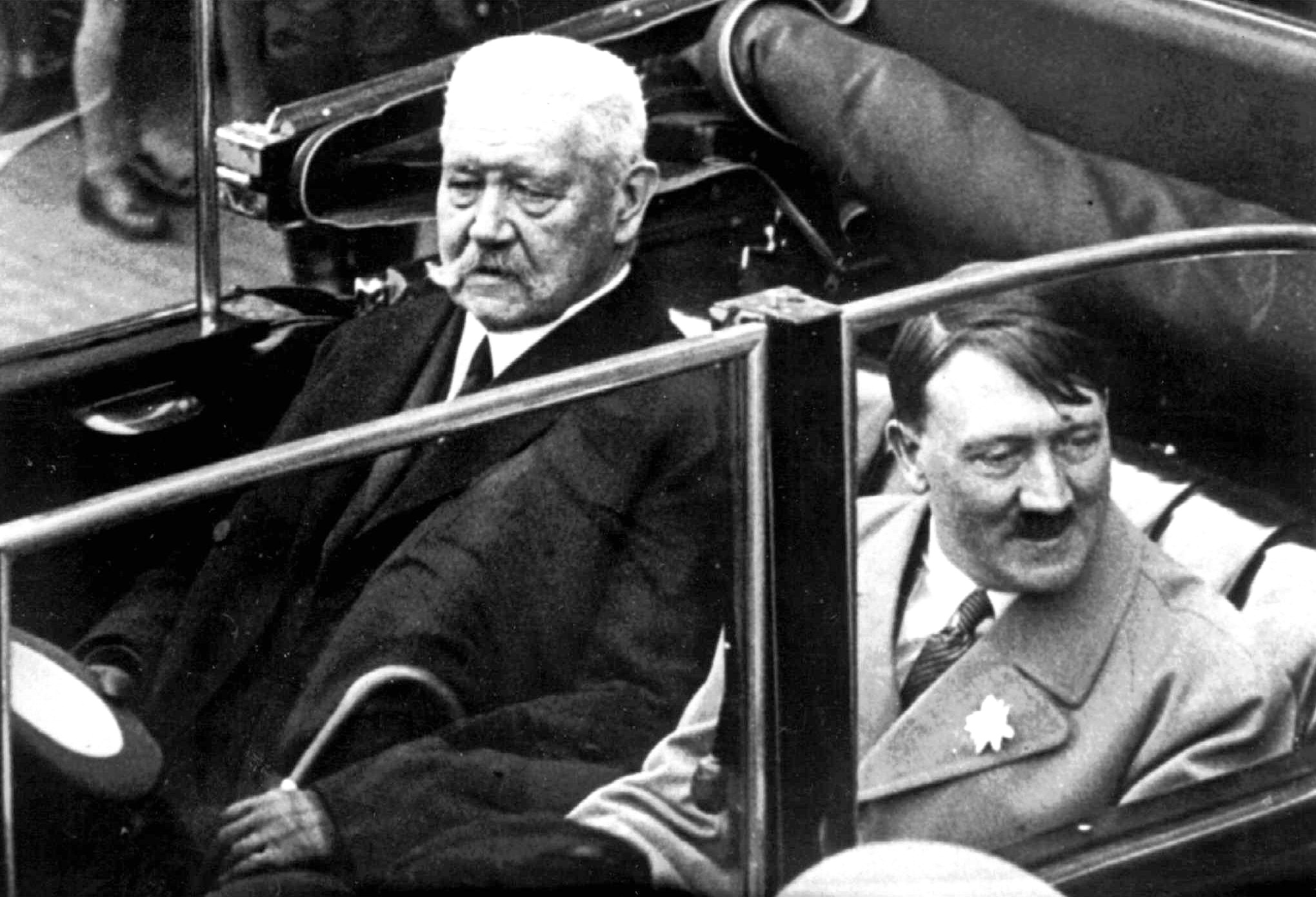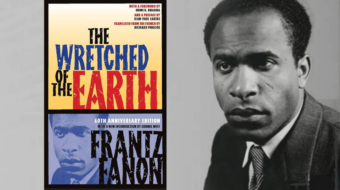
Since I was born in 1918 and remember the fascist takeover that happened in Germany in the 1930s, I’ve been asked, how did the highly-unionized German workers let that happen? You can look at the election results in Germany in 1932 and get a major part of the answer.
Nearly 36 million voted in the last free parliamentary election that year before Hitler took over, meaning that almost 18 million votes would be needed to form a majority in the parliament.
The results of that election were as follows:
- The Nazis received about 11,700,000 votes—the biggest party, but with a total that was actually down more than 4% from their showing in the prior election.
- The Social Democrats received 7,250,000 votes, which was down about 1% from the prior election.
- The Communists got almost 6,000,000 votes, actually more than they received in the prior election.
- All the others received just under 11,000,000 votes combined.

‘A Fight for Germany’: A 1932 Nazi election poster presents Hitler as the choice to stop the Communists and trade unions.
I combine all the rest because they had almost all supported Paul von Hindenburg, one of the three candidates in the presidential election of earlier that year. He was a right-of-center candidate with close connections to the armed forces and the old Prussian nobility. Even if the left had managed to get a majority in the parliamentary vote, they still would have had to contend with Hindenburg.
Besides him, the other two major candidates in the presidential election had been Adolf Hitler for the Nazis and Ernst Thälmann for the Communists. The Social Democrats did not run a candidate; they chose to back Hindenburg rather than support the Communists, with whom they refused to form a coalition.
Hindenburg won 49.5%, Hitler 30%, and Thälmann just over 13%. The Communists had campaigned on the slogan that a vote for Hindenburg was a vote for Hitler. As they predicted, within a year, he named Hitler as Chancellor.
The class interests at play
Ever since the end of World War I, there had been strong support among German workers for replacing capitalism with socialism. A socialist state was declared briefly in Germany, but it was crushed by the Social Democrats who were in power in Berlin. They sent in the army to do the dirty work.
The two “workers” parties, the Social Democrats and the Communists, needed to be united if there was ever to be a chance to establish worker power on a national level and prevent the rise of fascism in Germany. In 1923, in two of the largest German states, Thuringia and Saxony, the Social Democrats and the Communists did form coalitions and established pro-worker, anti-fascist governments in those states. The Social Democratic Party, headquartered in Berlin, however, called in the military once again to crush that coalition.
So, it is clear that the lack of unity between the two biggest non-fascist left parties, the Social Democrats and the Communists, was a major reason why fascism was able to take over in Germany. But it was by far not the only one.
The other big piece of the story was the powerful monopoly capitalist corporations, some of which were openly behind Hitler and the Nazis. They took the position that if Hitler were to be put in charge for awhile, he would eliminate the Communists and the trade unions. Then, later, big business and its political representatives could finish off Hitler once he’d served their purpose.
They accommodated themselves very easily to the Nazi regime once it was in power, though; they were quite happy with fascist rule since the concentration camps often provided them with sources of free labor. A parallel can be seen in big business support today for the MAGA fascist candidates in the U.S. Extreme right-wing lawmakers are being funded by top corporate honchos.
There were also non-fascist business interests in Germany who said, however, they would have nothing to do with supporting Communists or Social Democrats, so they backed Hindenburg and nationalist and centrist parties; they still thought he was a reliable right-winger who could keep Hitler in check. In the end, he was the leader who ended up elevating Hitler to power.

From the last 1932 parliamentary vote, we see that German workers wanted to get rid of capitalism and build socialism. So strong was German workers’ support for socialism and hatred of capitalism that Hitler felt compelled to add “Socialist” to his party’s name, Nationalsozialistische Deutsche Arbeiterpartei (National Socialist German Workers Party), shortened to “Nazi.” When he took power he, for the same reason, declared May Day as a national holiday.
But the choice in the German presidential election was not one between capitalism and socialism. It was a choice between two forms of capitalist government.
One choice was the Nazis, who were for capitalist fascism with no freedom of speech, press, assembly, no workers’ right to organize or workers’ rights to organize unions. They were funded by the most monopolistic, most imperialist, most racist sectors of German finance capital. So the unions, led mostly by Communists and the Social Democrats, were of course at the top of the Nazis’ most-hated list.
The other choice was capitalist government under Hindenburg, retaining some rights to free speech, press, assembly, or workers’ rights to organize unions. As it turns out, the 1932 elections and the Hindenburg victory proved to be the last chance to stop the Nazi drive for dictatorship. Hindenburg, the choice of the non-fascist business interests and the Social Democrats was the victor. But rather than blocking Hitler, Hindenburg became his ticket to power.
On January 30, 1933, he appointed Hitler chancellor—the head of the government. In turn, Hitler wasted no time preparing a complete Nazi takeover. It also reminds me of how fast Donald Trump moved to take over the U.S. judiciary, appointing young, lifetime-serving judges, right up to SCOTUS. Also, the way MAGA fascists in the U.S. have taken complete control of the Republican Party.
An excuse for dictatorship
Just one month after Hitler was appointed Chancellor, the Reichstag (Parliament) building was gutted by fire. Evidence that the fire was set by the Nazis themselves was suppressed, starting with the head of the Berlin Fire Department.
Walter Gempp, the fire chief, oversaw the initial investigations. He presented evidence suggesting Nazi involvement, saying there was a delay in notifying his brigade that the building was on fire and that he had been blocked from using all his firefighting resources that night. Within days, he was fired from his job. Eventually, he was arrested and murdered while in prison.
Hitler spread panic throughout Germany by claiming the burning of the Reichstag was just the first step in a war by the Communists to take over Germany. Hitler also used the fire to convince Hindenburg to declare an emergency decree suspending many civil liberties throughout Germany, including freedom of the press, freedom of expression, and the right to hold public assemblies. The police were authorized to detain citizens without cause.

Summary arrests of Communist Party leaders followed, with thousands imprisoned in the days following the fire. The total number of arrests in Prussia on the basis of the decree in the two weeks following the fire is believed to be in the vicinity of 10,000. Hermann Goering, whom Hitler had put in charge of the Prussian police, had actually employed such tactics even before the decree, only to have them thrown out by the courts—a check that no longer had any effect with the decree in place.
The Reichstag Fire Trials
The Communists accused of burning the Reichstag were given a public trial that began in March 1933 and ended on Aug. 31, 1933. As a teenager, I did not understand that creating a fascist dictatorship was a process that goes step after step, not something simply declared and completed overnight. I now wonder, “How far down the road to fascism did President Trump push us?”
Of the five Communists on trial for the Reichstag Fire, Georgi Dimitrov was outstanding for taking the offensive and exposing the lies of Nazi leaders like Goering and Goebbels. Eighty foreign correspondents attended and gave Dimitrov full coverage for exposing the Nazis’ crimes.
The courage of the Communist defendants at the Reichstag Fire trial and the total lack of evidence against them helped win their acquittal. Once out of prison Dimitrov went on to become an international leader in the fight against fascism and authored the important book United Front Against Fascism, available today as Against Fascism and War. It sounds as though it was written for the 2024 elections. I recommend it.
People’s World, on July 31, 2023, reprinted an article that answers the question I asked earlier, “How far down the road to fascism did President Trump and the Republicans take us?” The article, “Trump only one of many planning fascist take- over of the U.S.” sums it up:
“An authoritarian bloc with a fascist core is driving for control of all branches of the federal government. The authoritarian bloc, now operating under the banner of MAGA, has captured the Republican Party and the Supreme Court and holds trifectas in 22 states. And they are steadily moving ahead with plans to corner complete federal power in 2024.”
Coalition-building
The modern term for “united front” is coalition-building. The electoral coalition we urgently need to build is a pro-democratic-rights, pro-worker rights, anti-fascist coalition.

We may differ with members of the coalition on other issues. For example, as Communists, we strongly disagree with increasing the military budget and sending arms to keep the Ukraine war going. The expansion of nuclear weapons programs threatens the annihilation of humanity. At the same time that we are working to defeat Republican/fascist candidates in 2024, we must build a strong peace movement to win a ceasefire and negotiations to end the war in Ukraine.
The issue of unity to defeat the fascists remains front and center in our own 2024 elections. We have to be concerned, for example, that a third-party candidate in our 2024 presidential elections could split the anti-fascist vote and allow the MAGA fascists to win.
Fortunately, however, recent events have been encouraging. Unionizing surges everywhere, the solid contract victory won by UPS after vast strike preparations, the Ohio win that saved ballot initiatives, the Michigan rollback of right-to-work (for less), significant NLRB wins, Black Lives Matter rallies that include thousands of young white supporters, and in Chicago, the establishment of a Civilian Police Review Board. (I recently voted for my representatives to that body!)
Our working class is on the march. With unity, we will win!
John Wojcik contributed to this article.
As with all op-eds published by People’s World, this article reflects the opinions of its authors.
We hope you appreciated this article. At People’s World, we believe news and information should be free and accessible to all, but we need your help. Our journalism is free of corporate influence and paywalls because we are totally reader-supported. Only you, our readers and supporters, make this possible. If you enjoy reading People’s World and the stories we bring you, please support our work by donating or becoming a monthly sustainer today. Thank you!










